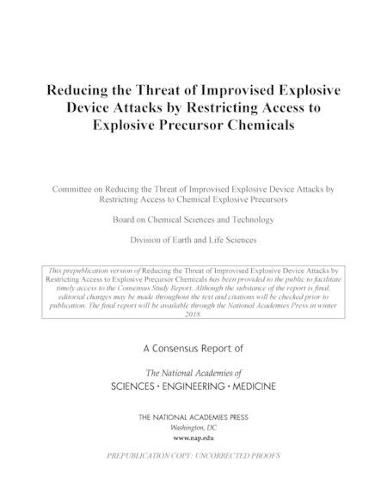Readings Newsletter
Become a Readings Member to make your shopping experience even easier.
Sign in or sign up for free!
You’re not far away from qualifying for FREE standard shipping within Australia
You’ve qualified for FREE standard shipping within Australia
The cart is loading…






Improvised explosive devices (IEDs) are a type of unconventional explosive weapon that can be deployed in a variety of ways, and can cause loss of life, injury, and property damage in both military and civilian environments. Terrorists, violent extremists, and criminals often choose IEDs because the ingredients, components, and instructions required to make IEDs are highly accessible. In many cases, precursor chemicals enable this criminal use of IEDs because they are used in the manufacture of homemade explosives (HMEs), which are often used as a component of IEDs.
Many precursor chemicals are frequently used in industrial manufacturing and may be available as commercial products for personal use. Guides for making HMEs and instructions for constructing IEDs are widely available and can be easily found on the internet. Other countries restrict access to precursor chemicals in an effort to reduce the opportunity for HMEs to be used in IEDs. Although IED attacks have been less frequent in the United States than in other countries, IEDs remain a persistent domestic threat. Restricting access to precursor chemicals might contribute to reducing the threat of IED attacks and in turn prevent potentially devastating bombings, save lives, and reduce financial impacts.
Reducing the Threat of Improvised Explosive Device Attacks by Restricting Access to Explosive Precursor Chemicals prioritizes precursor chemicals that can be used to make HMEs and analyzes the movement of those chemicals through United States commercial supply chains and identifies potential vulnerabilities. This report examines current United States and international regulation of the chemicals, and compares the economic, security, and other tradeoffs among potential control strategies.
$9.00 standard shipping within Australia
FREE standard shipping within Australia for orders over $100.00
Express & International shipping calculated at checkout
Improvised explosive devices (IEDs) are a type of unconventional explosive weapon that can be deployed in a variety of ways, and can cause loss of life, injury, and property damage in both military and civilian environments. Terrorists, violent extremists, and criminals often choose IEDs because the ingredients, components, and instructions required to make IEDs are highly accessible. In many cases, precursor chemicals enable this criminal use of IEDs because they are used in the manufacture of homemade explosives (HMEs), which are often used as a component of IEDs.
Many precursor chemicals are frequently used in industrial manufacturing and may be available as commercial products for personal use. Guides for making HMEs and instructions for constructing IEDs are widely available and can be easily found on the internet. Other countries restrict access to precursor chemicals in an effort to reduce the opportunity for HMEs to be used in IEDs. Although IED attacks have been less frequent in the United States than in other countries, IEDs remain a persistent domestic threat. Restricting access to precursor chemicals might contribute to reducing the threat of IED attacks and in turn prevent potentially devastating bombings, save lives, and reduce financial impacts.
Reducing the Threat of Improvised Explosive Device Attacks by Restricting Access to Explosive Precursor Chemicals prioritizes precursor chemicals that can be used to make HMEs and analyzes the movement of those chemicals through United States commercial supply chains and identifies potential vulnerabilities. This report examines current United States and international regulation of the chemicals, and compares the economic, security, and other tradeoffs among potential control strategies.